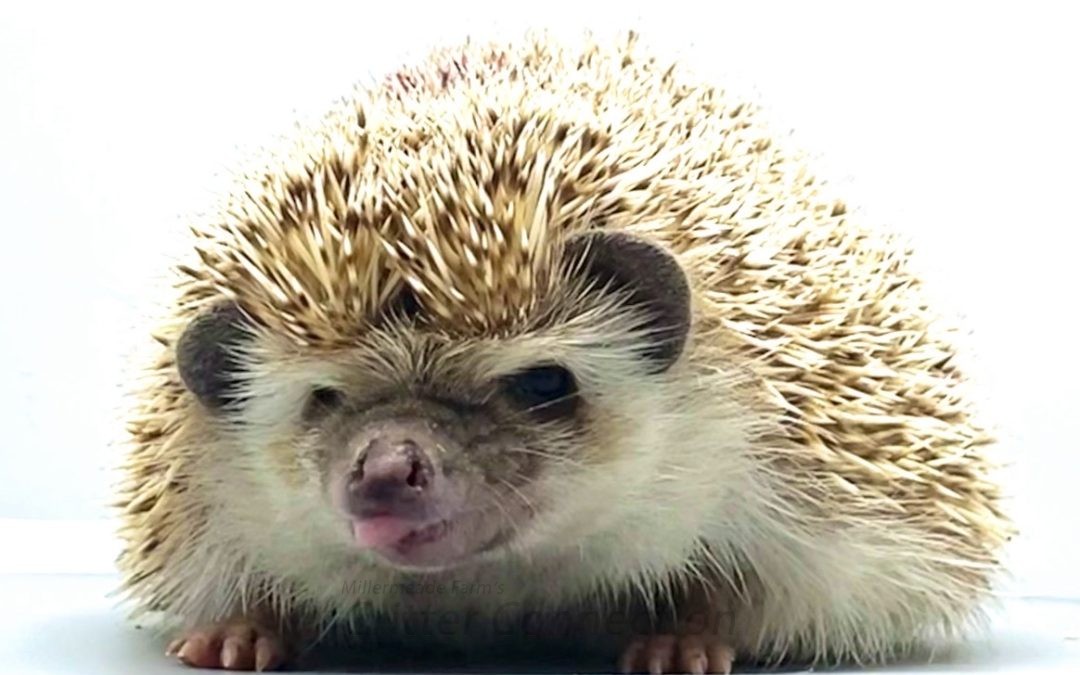Last Updated on October 26, 2022.
Many veterinarians will agree that one of the most common medical problem seen in captive hedgehogs is obesity and obesity related problems.
Cause
- Diet
- A few hedgehog enthusiasts discourage limiting a hedgehog’s food and claim that hedgehogs will not over eat. However, an overwhelming number of experts and enthusiast disagree.
- Hedgehogs can overeat even on a low-fat hedgehog diet, so food intake often must be restricted to maintain proper body weight.
- Overeating of foods too high in fat and protein such as regular cat food and fatty insects such as wax worms, mealworms, and superworms is a significant culprit of obesity.
- Exercise
- Lack of exercise is also a huge contributing factor.
- Cages that are too small can limit exercise and activity.
- However, when hedgehogs are a healthy weight they can become more active by running on their wheel and exploring their cage at night.
- Other
- Some hedgehogs are prone to obesity due to genetic predisposition.
- Other hedgehogs can become overweight in preparation for a lengthy hibernation that they would experience in the wild, but in captivity that never comes. Hibernation attempts in captivity can
Detection
- Weight
- There is no standard weight for a hedgehog.
- The reason being that the sizes vary quite a lot from one breeder to another, so figuring out what is obese can be difficult.
- The typical healthy hedgehog is actually usually on the plump side but is teardrop shaped instead of round when not balled up.
- Since there is such a wide variety of size in domestic stock these days, an obese hedgehog can be as little as eight ounces to as much as two pounds in weight, so weight guidelines are of little use in identifying a fat hedgehog!
- Of far more use to you than a set of scales is a weekly or monthly visual inspection of your pet’s front legs and chin. Hedgehog Central (See below)
- A gram scale is more accurate in measuring weight than a standard bathroom scale.
- Observation
- Healthy hedgehogs appear twice as long as they are wide; they are not round in shape.
- The best way to determine if a hedgehog is obese is to observe other factors beyond the weight
- The furrow on the head should be able to pull down; if it cannot due to fat rolls, this is a sign of obesity
- A hedgehog should also be able to roll into a ball without too much trouble
- Fat deposits around the eyes can form (one or both)
- A double-chin is also an indicator of fat
- Fat “ham-hock” type legs instead of muscular legs
- Rolls of fat underneath the armpits can indicate too much weight
- Yellow tints to the skin under the legs may also be a symptom
- Hedgehogs should also be able to move around their cage without their stomachs dragging on the ground (some hedgehogs do walk closer to bedding, so it needs to be observed if the hedgehog is just close to the ground or if it is actually fat that is drooping)
Treatment
- Extra caution is required in weight reduction because a drastic reduction of weight can trigger Hepatic Lipidosis (Fatty Liver Disease). Fatty Liver Disease can be fatal if not treated.
- Discuss a weight reduction plan with your veterinarian for the best chance of success. This guide can be used as a discussion tool with your veterinarian.
- Diet
- Decrease and/or eliminate high fat foods and treats in the diet.
- Reduce the calories in the diet by switching to lower fat formulas and decreasing food intake.
- Encourage foraging behaviors by hiding food around the cage instead of using a food bowl.
- One suggestion given on Hedgehog Central is to actually change the type of dry food that you are feeding to one that has a fat content of at least 20 percent. The theory is that added fat will cause your pet to “bulk-up” and eat less and will actually help it to lose weight. This treatment plan should only be used after all other treatments have proven unsuccessful and with veterinary guidance.
- Exercise
- A wheel provides exercise and stimulation but lazy hedgehogs may not use it.
- A new style of wheel may be more comfortable for the hedgehog and therefore increase wheel activity.
- It is important to ensure that the wheel is the correct size for your hedgehog.
- Increase the hedgehog’s cage size and time exercising outside of the cage.
- Letting a hedgehog hibernate is NOT the answer for hedgehogs believed to add weight for winter hibernation.
Dangers Associated With Obesity
- Untreated obesity can lead to an early death due through other health complications.
- Obesity increases the risk of tumor development.
- Fatty Liver disease is also a complication of obese hedgehogs without a weight loss plan.
- Heart attacks are also associated with obesity.
- Fat Deposits Around Eyes
- This problem is a very common problem with overweight guinea pigs and can happen to hedgehogs as well.
- One of both eyes can be affected.
- A low fat diet and additional opportunities for exercise is the best treatment.
- When the hedgehog loses weight the fat deposits will most likely disappear.
References:
Klein, Tom: Hedgehog Drug Therapies; E Hilliard Vet Clinic, Columbus, OH. 614-876-7762
Finney, Des: The Most Common Hedgehog Diseases
Primary Author:
Gail Smith, Millermeade Farms “Critter Connection”
Contributers: Dr. Kirsten (Love) Carpenter and Lauren Benedict, Melissa Ramos






